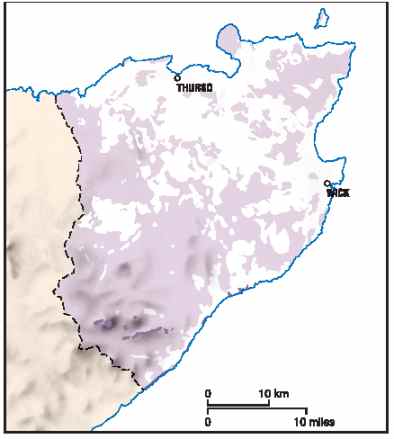|
Heather moor Habitats and species In places where the peat has ceased to grow, through drainage or where the soils are drier (mineral rich), the vegetation becomes dominated by heather. Left alone, this habitat would gradually transform to birch woodland, but burning and grazing prevents the trees from prospering. Large areas of Caithness consist of heather moor studded with small acid lochs and crossed with burns and rivers. The scale of this land makes it locally important. There are scattered plants of interest, such as creeping ladyís tresses, but the main natural interest is the bird and insect life. Red-throated and black-throated divers, wigeon, golden plover, short-eared owl, hen harrier, merlin and peregrine falcons inhabit this country.
For the past 120 years the heather moor, which is classed as lowland and upland heathland by the UK Biodiversity Action Plan, has been devoted to sporting interest, mainly deer stalking with some grouse shooting and salmon and trout fishing in the lochs and rivers. Sheep have been grazed in varied numbers over the past 200 years, prior to which it was used to graze black cattle. In recent times, large areas of heather moor have been planted with conifer trees. Main issues
|
Hills
Habitats and species
However, the wind exposure and low summer temperatures make these hills alpine habitats in the UK context. There is also a range of rock types, which leads to a greater diversity of flora including alpine bearberry, alpine saxifrage and cloudberry. Morven is conglomerate rock with scree, and has alpine bearberry and alpine saxifrage, as well as the scarce rock whitlow-grass. Scaraben is a quartzite hill with little soil and an impoverished flora. Smean is a craggy sandstone hill with crevices of richer minerals bearing green spleenwort and Wilsonís filmy fern. Ptarmigan and ring ouzel can be found here, as well as mountain hare and large heath butterfly.
Main issues The special alpine plants are unusually vulnerable to climate change, as they are located on small hills close to sea level.
There are very few real montane areas in Caithness,
and considerations on future proposals such as wind farm developments
should consider the implications on local Morven and Scaraben are popular hills for recreation, and this may be a contributory factor to why birds such as golden eagle do not nest there.
|




